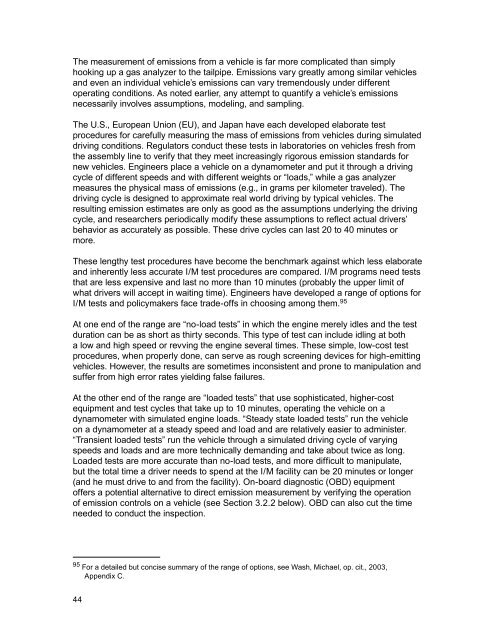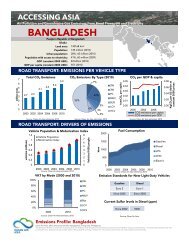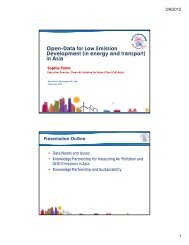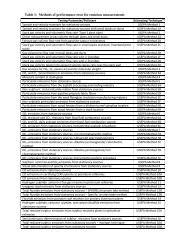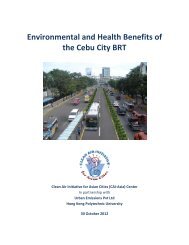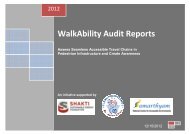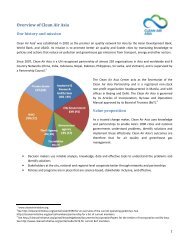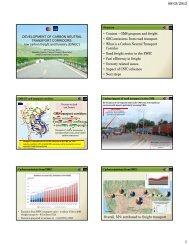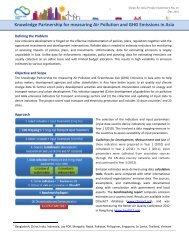International Experience and Best Practices - Clean Air Initiative
International Experience and Best Practices - Clean Air Initiative
International Experience and Best Practices - Clean Air Initiative
Create successful ePaper yourself
Turn your PDF publications into a flip-book with our unique Google optimized e-Paper software.
The measurement of emissions from a vehicle is far more complicated than simply<br />
hooking up a gas analyzer to the tailpipe. Emissions vary greatly among similar vehicles<br />
<strong>and</strong> even an individual vehicle’s emissions can vary tremendously under different<br />
operating conditions. As noted earlier, any attempt to quantify a vehicle’s emissions<br />
necessarily involves assumptions, modeling, <strong>and</strong> sampling.<br />
The U.S., European Union (EU), <strong>and</strong> Japan have each developed elaborate test<br />
procedures for carefully measuring the mass of emissions from vehicles during simulated<br />
driving conditions. Regulators conduct these tests in laboratories on vehicles fresh from<br />
the assembly line to verify that they meet increasingly rigorous emission st<strong>and</strong>ards for<br />
new vehicles. Engineers place a vehicle on a dynamometer <strong>and</strong> put it through a driving<br />
cycle of different speeds <strong>and</strong> with different weights or “loads,” while a gas analyzer<br />
measures the physical mass of emissions (e.g., in grams per kilometer traveled). The<br />
driving cycle is designed to approximate real world driving by typical vehicles. The<br />
resulting emission estimates are only as good as the assumptions underlying the driving<br />
cycle, <strong>and</strong> researchers periodically modify these assumptions to reflect actual drivers’<br />
behavior as accurately as possible. These drive cycles can last 20 to 40 minutes or<br />
more.<br />
These lengthy test procedures have become the benchmark against which less elaborate<br />
<strong>and</strong> inherently less accurate I/M test procedures are compared. I/M programs need tests<br />
that are less expensive <strong>and</strong> last no more than 10 minutes (probably the upper limit of<br />
what drivers will accept in waiting time). Engineers have developed a range of options for<br />
I/M tests <strong>and</strong> policymakers face trade-offs in choosing among them. 95<br />
At one end of the range are “no-load tests” in which the engine merely idles <strong>and</strong> the test<br />
duration can be as short as thirty seconds. This type of test can include idling at both<br />
a low <strong>and</strong> high speed or revving the engine several times. These simple, low-cost test<br />
procedures, when properly done, can serve as rough screening devices for high-emitting<br />
vehicles. However, the results are sometimes inconsistent <strong>and</strong> prone to manipulation <strong>and</strong><br />
suffer from high error rates yielding false failures.<br />
At the other end of the range are “loaded tests” that use sophisticated, higher-cost<br />
equipment <strong>and</strong> test cycles that take up to 10 minutes, operating the vehicle on a<br />
dynamometer with simulated engine loads. “Steady state loaded tests” run the vehicle<br />
on a dynamometer at a steady speed <strong>and</strong> load <strong>and</strong> are relatively easier to administer.<br />
“Transient loaded tests” run the vehicle through a simulated driving cycle of varying<br />
speeds <strong>and</strong> loads <strong>and</strong> are more technically dem<strong>and</strong>ing <strong>and</strong> take about twice as long.<br />
Loaded tests are more accurate than no-load tests, <strong>and</strong> more difficult to manipulate,<br />
but the total time a driver needs to spend at the I/M facility can be 20 minutes or longer<br />
(<strong>and</strong> he must drive to <strong>and</strong> from the facility). On-board diagnostic (OBD) equipment<br />
offers a potential alternative to direct emission measurement by verifying the operation<br />
of emission controls on a vehicle (see Section 3.2.2 below). OBD can also cut the time<br />
needed to conduct the inspection.<br />
95 For a detailed but concise summary of the range of options, see Wash, Michael, op. cit., 2003,<br />
44<br />
Appendix C.


